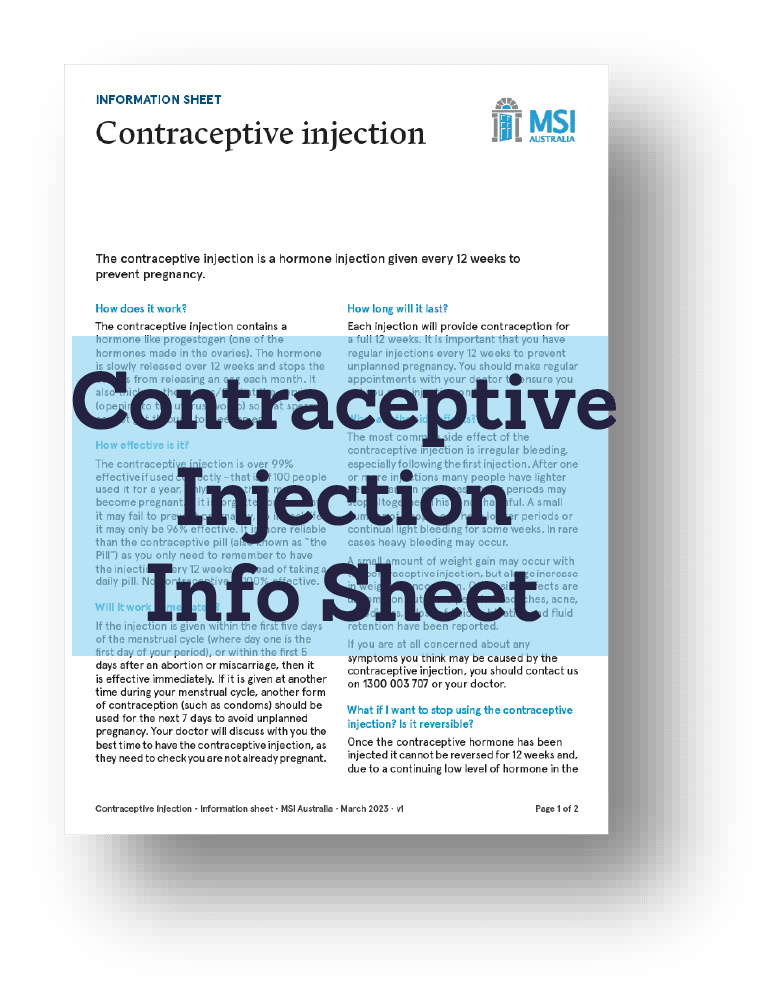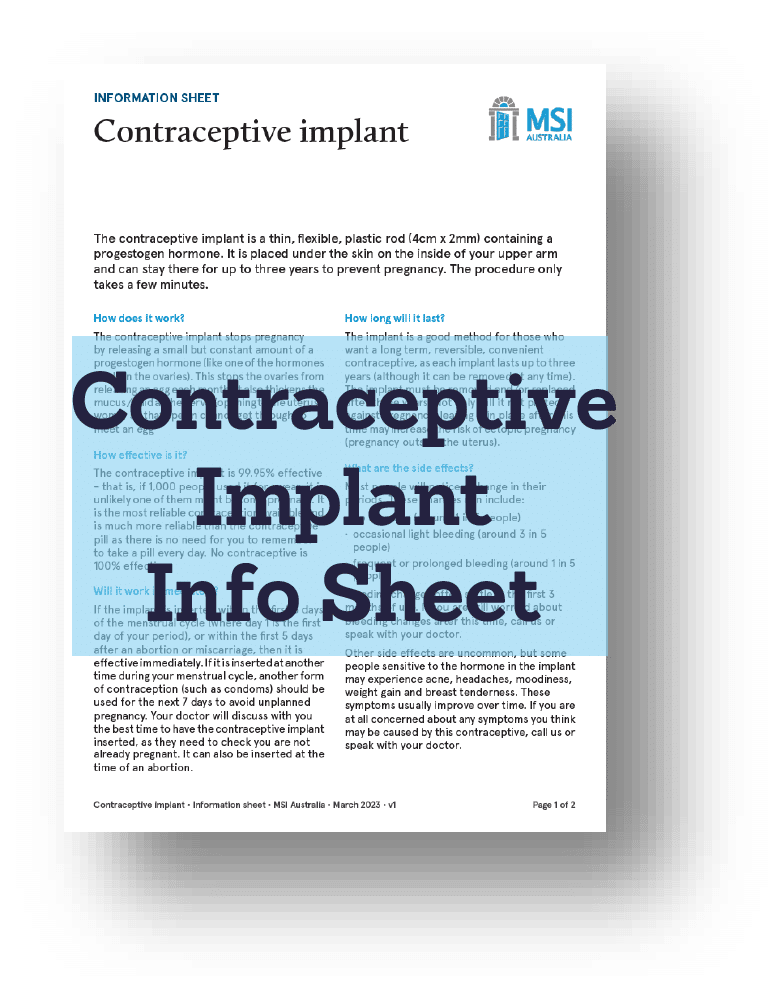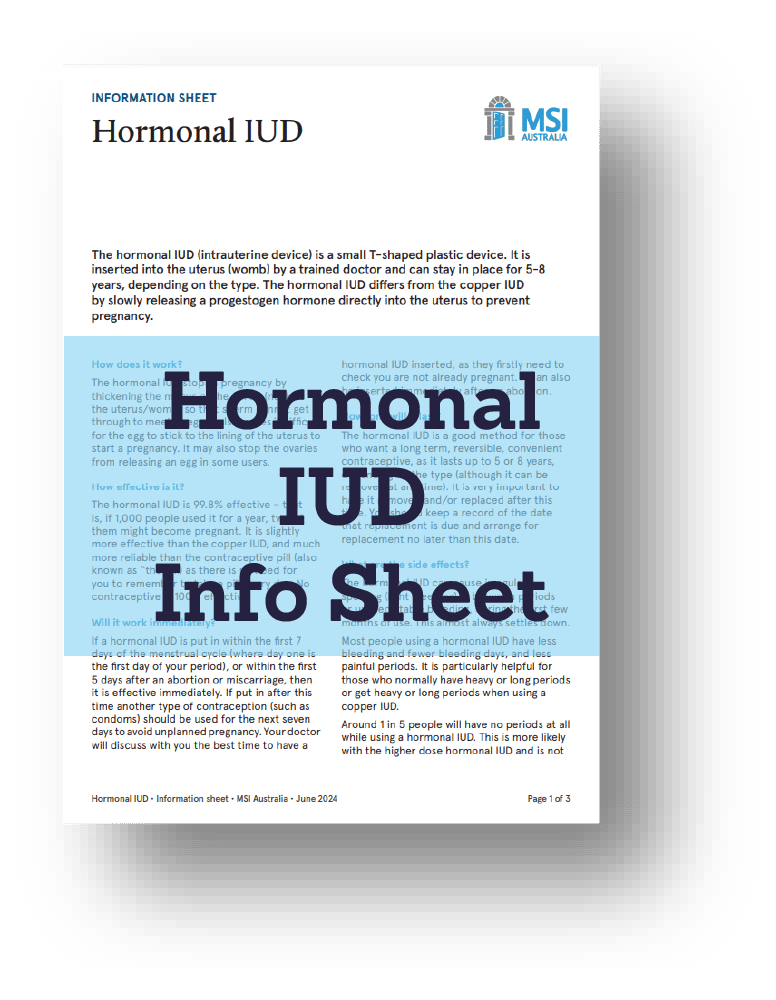Long-acting reversible contraception (LARC)

Long-acting reversible contraception (LARC) is a category of ‘set-and-forget’ contraceptive methods that prevent unplanned pregnancy with high reliability and efficacy. They do not require the user to adhere to a daily or episodic regime, as demanded by hormonal birth control pills or condoms, and maintain a high degree of protection over months and years.
Our clinics offer a full range of LARC options and consultation services on methods such as contraceptive injection, contraceptive implant or rod, the copper intrauterine device (IUD) and intrauterine hormonal system (IUS). We also provide safe, permanent vasectomy procedures for men.
Choosing a LARC from the range of options available is a matter of working out what is right for your situation. For instance, long-acting reversible contraception reliably protects against unplanned pregnancy but does not protect against sexually transmitted infections.
Whatever you decide, you need to feel confident that you are reliably protected against unplanned pregnancy. For more information, head to our Contraception Services page. To find out which type of contraception option suits you best, take our contraception quiz.
Speak to our friendly staff on 1300 003 707 or book online for a LARC appointment.
Compare your LARC options
If you would like a non-invasive and discreet contraceptive method, the contraceptive injection may be suitable for you.
The contraceptive injection is an injection of hormone that provides long acting protection from unplanned pregnancy. It works by slowly releasing the hormone progestogen into the body to prevent ovulation.
You should not use this contraceptive method if you do not want your periods to change. Irregular bleeding is a possible side effect of the contraceptive injection, however, with time, you may no longer menstruate while using this method, and this may be an advantage for some people.
The contraceptive injection is a very effective family planning method (over 99% effective with perfect use) and is more reliable than the contraceptive pill, as you only need to remember to have the injection every 12 weeks, instead of taking a daily pill.
It is important to have a repeat injection on time, every 12 weeks, otherwise it becomes only 94% effective with typical use.
The contraceptive injection doesn’t offer any protection against sexually transmitted infections or HIV/AIDS.
Long term use of the contraceptive injection may reduce the mineral content of bone in some women and people with uteruses, which is likely to be reversible when the injections are stopped. Because of this, if you are under 18 or over 45, the injection may not be the first choice of contraception for you.
It can also delay your return to normal rates of fertility. So if you would like to become pregnant within 12 months, it is important to talk to your MSI Australia doctor or nurse about your contraception options.
The contraceptive injection must be prescribed by a doctor from one of our centres, your local doctor or a family planning centre. Following the initial consultation and your consent, the doctor or nurse will administer a small, quick injection of the contraceptive into your buttock or into the muscle of your upper arm.
Find out more in our Contraceptive Injection FAQs.
If you are looking for a family planning method that is highly effective and does not require you to keep a regular routine, the contraceptive implant may be a good option.
The implant is a thin, flexible, plastic rod (4cm x 2mm), about the size of a matchstick, which contains the hormone progestogen.
The implant prevents pregnancy by releasing small but constant amounts of the hormone into the body via the bloodstream. The hormone blocks ovulation (the release of eggs from the ovaries) and it also thickens the mucus at the cervix so that sperm cannot get through to meet an egg. The implant lasts for three years, but it is easily reversible if you no longer want it.
The contraceptive implant is a very effective type of contraception (>99.9%). It is more reliable than the contraceptive pill, as you won’t need to remember to take a pill at the same time every day. You should not use this contraceptive method if you do not want your periods to change. It does not protect against contracting sexually transmitted infections (STIs) or HIV/AIDS.
The contraceptive rod implant is a good method for those who want a long term, reversible, convenient contraceptive, as each implant lasts up to three years (although it can be removed at any time). The implant must be removed and/or replaced after three years. Not only will it not protect against pregnancy, leaving it in place after this time may increase the risk of ectopic pregnancy (pregnancy outside the uterus).
Find out more in our Contraceptive Implant FAQs.
There are 3 forms of intrauterine contraception available in Australia: the copper IUD and 2 different hormonal IUDs. One hormonal IUD is slightly smaller in size and has less hormones than the other. Each of them is long-acting, reversible and effective forms of contraception that work to prevent pregnancy.
Key information
- More than 99% effective in preventing pregnancy
- Last between five to ten years, depending on type chosen
- Chances of getting pregnant return to normal as soon as it is removed
- Cost-effective when compared to other methods due to how long protection lasts
- ‘Set-and-forget’ method, so great for regular travellers and women would prefer not to adhere to a daily method
- Nylon strings can be adjusted to suit your body and should not be felt by either partner during sex
IUDs do not protect against sexually transmitted infections (STIs) or HIV/AIDS and condoms should be used if you are at risk.
Find out more in our Intrauterine contraception IUD FAQs.
Contact our friendly staff
Make a contraception booking, suited to your needs
Contraception costs
Intrauterine Device (IUD) without Sedation Cost
Starting price- Prices are based on the minimum cost for each procedure for clients holding a valid Health Care Card. If you would like to have an IUD or contraceptive implant removed or replaced, contact us for pricing.
- Prices quoted do not include the cost of the device. $300 is lowest Health Care Card price; $335 is lowest Medicare Card Price.
- You can use Penthrox (“Green Whistle”) for pain relief for an extra $55. For details, consult our healthcare practitioner or call 1300 003 707.
Intrauterine Device (IUD) with Sedation Cost
Starting price- Prices are based on the minimum cost for each procedure for clients holding a valid Health Care Card. If you would like to have an IUD or contraceptive implant removed or replaced, contact us for pricing.
- Prices quoted do not include the cost of the device. $480 is lowest Health Care Card price; $510 is lowest Medicare Card Price.
Contraceptive Implant Cost
Starting price- Prices are based on the minimum cost for each procedure for patients holding a valid Health Care Card. If you would like to have an IUD or contraceptive implant removed or replaced, contact us for pricing.
- Prices quoted do not include the cost of the device. $190 is lowest Health Care Card price; $235 is lowest Medicare Card Price.
Contraceptive Injection Cost
Starting price- Prices are based on the minimum cost for each procedure for patients holding a valid Health Care Card. If you would like to have an IUD or contraceptive implant removed or replaced, contact us for pricing.
- Prices quoted do not include the cost of the injection. $100 is Health Care Card price and Medicare Card Price.
Reliable contraception FAQs
What is a copper intrauterine device (IUD)?
A copper intrauterine device (copper IUD) is a small device fitted into the uterus, where it can remain for many years to prevent pregnancy. A copper IUD prevents sperm from fertilising an egg or prevents an egg from implanting in the uterus. IUDs are made of plastic with copper and only take a couple of minutes to be inserted by a trained doctor.
Copper IUDs are effective for up to 10 years. Copper IUDs can also be used as an emergency method of contraception within 5 days of unprotected intercourse or 5 days after expected ovulation.
Visit the copper intrauterine contraception page for more information about the copper IUD.
What is an intrauterine hormonal system (IUS)?
An intrauterine system (IUS), sometimes known as a hormonal IUD, is a small plastic device fitted into the uterus. It prevents pregnancy by gradually releasing a progestogen hormone directly into the uterus, thickening the mucus at the cervix so that sperm cannot get through to meet an egg. The IUS also interferes with the movement of sperm, changing the lining of the womb and preventing an egg from implanting.
Visit the hormonal intrauterine contraception page for more information about the hormonal IUD.
What is a contraceptive implant?
The contraceptive implant is a thin, flexible, plastic rod (4cm x 2mm), about the size of a matchstick, which contains the hormone progestogen.
The implant prevents pregnancy by releasing small but constant amounts of the hormone into the body via the bloodstream. The hormone blocks ovulation (the release of eggs from the ovaries), and thickens the mucus at the cervix so that sperm cannot get through to meet an egg. The implant lasts for 3 years, but it is easily removed if you decide you no longer need it.
Visit the contraceptive implant page for more information.
What is a contraceptive injection?
The contraceptive injection is an injection of hormones that provides long-acting protection from unplanned pregnancy. It works by slowly releasing the hormone progestogen into the body to prevent ovulation.
It is important to have a repeat injection on time (every 12 weeks) otherwise, it becomes ineffective. Irregular bleeding is a possible side effect of the contraceptive injection; however, no periods may be advantageous for some.
Visit the contraceptive injection page for more information.
Contraceptive injection FAQs
How is the contraceptive injection given?
During your consultation your doctor will firstly discuss the advantages and disadvantages of the contraceptive injection and assess its suitability as a contraceptive method. Following the initial consultation and your consent, the doctor or nurse will administer a small, quick injection of the contraception into your buttock or into the muscle of your upper arm.
What are the side effects of the contraceptive injection?
The most common side effect of the contraceptive injection is the occurrence of irregular bleeding patterns, especially following the first injection. After one or more injections many women experience lighter periods and in many cases periods may stop altogether. This is not harmful and is often seen as an advantage of the contraceptive injection.
Some women may experience longer periods or continual light bleeding for some weeks and in rare cases heavy bleeding may occur. A small amount of weight gain may occur with the contraceptive injection, but a large increase in weight is uncommon. Other side effects are uncommon but headaches, acne, moodiness, a loss of libido, bloating and fluid retention can occur for some women.
Will the contraceptive injection be effective immediately?
If the contraceptive injection is given within the first five days of the menstrual cycle (where day one is the first day of your period), then it is effective immediately. If it is given at another time during your menstrual cycle, another type of contraception (such as condoms) should be used for the next seven days to avoid unplanned pregnancy. Your doctor will discuss with you the best time to have the injection, as they first need to ensure you are not already pregnant.
Can I have the contraceptive injection if I am breastfeeding?
The contraceptive injection is widely considered to be a safe method to use during breastfeeding from delivery.
Where can I get the contraception injection?
A doctor’s prescription is required to obtain a contraceptive injection, which you can get from your local GP, sexual health clinic or MSI Australia clinic. Only a doctor or nurse should administer the injection. To make an appointment for a MSI Australia contraceptive injection consultation, call or book online.
How long will the contraceptive injection last?
Each contraceptive injection will provide protection from pregnancy for a full 12 weeks only, so it’s important that you have regular injections every 12 weeks to avoid unplanned pregnancy. You should make regular, forward appointments with your doctor to ensure ongoing contraceptive cover. Ultimately it is your responsibility to make an appointment to visit your doctor.
Is the contraceptive injection reversible?
Once the contraceptive hormone has been injected it cannot be reversed for 12 weeks and, due to a continuing low level of hormone in the body following the final injection, there may be a further delay in the return of the normal menstrual cycle. When you stop the contraceptive injections it may take many months for your periods to return to normal (an average of eight months) and up to 18 months for your fertility to return to normal. Despite this, it is important to start using another form of contraception within 12 weeks of the last injection if you do not want to get pregnant.
Contraceptive implant FAQs
How do I get a contraceptive implant?
A doctor’s prescription is required to obtain a contraceptive implant, from your local GP, sexual health clinic or MSI Australia clinic. Only a specially trained doctor or nurse should insert the contraceptive implant. To make an appointment for a MSI Australia contraceptive implant consultation, call us or book online.
How is the contraceptive implant inserted?
At your consultation the doctor will discuss the advantages and disadvantages of the implant and assess its suitability as a contraceptive method. Once you have given consent, the doctor will inject a small amount of local anaesthetic under the skin on the inside of your upper arm. When the anaesthetic has taken effect, the doctor will insert the contraceptive implant just under the skin in your arm using a sterile disposable applicator. A dressing will then be applied which should be left in place for 24 hours. The procedure of inserting the implant only takes a few minutes. There may be some bruising, soreness or discomfort around the implant following the insertion, which should last no longer than one week.
What are the side effects of the contraceptive implant?
Some women are sensitive to the hormones in the implant and may experience acne, headaches, moodiness, weight gain and breast tenderness. These symptoms usually improve over time. If you are concerned about any symptoms you think may be caused by the contraceptive implant, consult your doctor.
There may be some minor scarring after the insertion or removal of the implant, and some women are predisposed to develop a thicker scar. A larger scar is likely if the implant is difficult to remove. On rare occasions the implant may move from its original position, which may complicate removal.
Do you get your period when you have a contraceptive implant?
Most women will experience a change in their periods after the insertion of the contraceptive implant. These changes can include: periods ceasing (in around 20% of women); periods regular but lighter and less painful; intermittent bleeding in between periods; heavier, longer or more painful periods. While unusual bleeding often settles down within three months, around 20% of women will continue to have frequent, irregular or prolonged bleeding patterns. In this case, you might choose to have the implant removed.
Will the contraceptive implant be effective immediately?
If the contraceptive implant is inserted within the first five days of the menstrual cycle (where day one is the first day of your period), then it is effective immediately. If it is inserted at another time during your menstrual cycle, another type of contraception (such as condoms) should be used for the next seven days to avoid unplanned pregnancy. Your doctor will discuss with you the best time to have the implant inserted and will also ensure you are not already pregnant.
How long does the contraceptive implant last?
The implant is a good type of contraception for women who want a long-term, reversible, convenient family planning method, as each implant lasts up to three years. For this reason, it is a very cost effective contraceptive method.
The implant must be removed and/or replaced after three years. If you leave it in place beyond three years you will not be protected from pregnancy and you may increase your risk of ectopic pregnancy (pregnancy outside the uterus). Your doctor will give you a card that records the date that your implant must be removed and/or replaced, but ultimately it is your responsibility to make an appointment to visit your doctor.
Is the contraceptive implant reversible?
The contraceptive implant can be easily removed by a doctor, which makes it an easily reversible contraceptive method. Most women return to a normal menstrual cycle and previous fertility within a month of the implant being removed. If you do not want to get pregnant, you need to use another form of contraception as soon as the device is removed.
How is the contraceptive implant removed?
A doctor removes the contraceptive implant in a simple procedure which only takes a few minutes. Local anaesthetic is injected into the area around the end of the implant and a tiny incision is then made in the skin, through which the implant is removed. Stitches are rarely required. Although the implant rarely moves, if it has moved from its original position it could make removal more difficult. A dressing is then applied and should be left in place for 24 hours.
Can I use the contraceptive implant if I am breastfeeding?
The implant is considered to be safe to use during breastfeeding from delivery.
Intrauterine contraception IUD FAQs
How do I get an IUD inserted or fitted?
An IUD must be inserted by a specially trained doctor and can be inserted by some GPs, at sexual health clinics and at Marie Stopes clinics.
Most importantly, you must ensure that you are not pregnant so either have it inserted during or immediately after your period, or use reliable contraception until it can be fitted.
How is the IUD inserted?
Once you have consented to the procedure, the doctor will insert a speculum into your vagina to view your cervix (the same process as having a cervical screening, also known as a pap smear). A thin, flexible plastic tube is used to insert the IUD into the uterus. The tube is then removed, leaving the device in place and the nylon thread length adjusted to suit you.
A small amount of local anaesthetic may be used to numb the cervix prior to the device being fitted, or at your request. The insertion usually only takes a few minutes.
Some women may find the insertion uncomfortable or feel slightly faint after insertion or removal of the device. This is a normal reaction that should pass within a few minutes. You may take a mild pain killer prior to, or after, the insertion. At some clinics you can also request sedation at an additional cost. Please enquire when you book, as you will need to fast and plan to have someone take you home.
To avoid infection, do not insert anything into your vagina for 48 hours following the insertion (i.e. avoid sexual penetration and use pads instead of tampons for at least two days). You will usually be asked to return for a check-up after your first period, about six weeks after insertion, and you should regularly check the string after your period to check the device remains in place.
How is an IUD removed?
Removal of an IUD is an easier procedure than insertion and it can be removed at any time in your menstrual cycle by a trained doctor. However, if you do not want to become pregnant it is important to use an alternative method of contraception in the week leading up to the removal of the device.
Sexual activity during this week could result in an unplanned pregnancy once the device is removed. Always see a doctor for removal of an IUD.
It is possible to have a new IUD inserted immediately after the previous one is removed.
How long does it take for an IUD to be effective?
This depends on whether a hormonal or copper IUD is used. If a hormonal IUD is inserted in the first seven days of your menstrual cycle (where day one is the first day of your period) then it is effective immediately, otherwise another type of contraception (such as condoms) should be used for the next seven days to avoid unplanned pregnancy.
A copper IUD is effective immediately after insertion. If you are using another method of contraception and are changing to an IUD, you will need to discuss with your doctor when is the best time for the device to be inserted to avoid an unplanned pregnancy.
Can I use an IUD if I am breastfeeding?
Yes, IUD are widely considered a safe method of contraception in breastfeeding women and can be inserted 4 weeks after you give birth.
How do I know if my IUD has moved?
IUDs have two fine nylon strings attached to them which, when in place, come out through the cervix. It is important for you to learn how to feel for the strings of the device yourself to check that it remains correctly in place. At your consultation your doctor will explain how and when to do this.
Will we be able to feel the IUD during sex?
Neither you or your partner should be aware of the IUD during sex. If you experience any discomfort you should have the positioning checked by your doctor.
When is an IUD not recommended?
Before having an IUD inserted you must inform your doctor if you: might be pregnant; have had a history of any unusual vaginal bleeding or painful or heavy periods; have fibroids or other abnormalities in the uterus; have an existing sexually transmitted disease (STI) or pelvic infection; have had an abnormal cervical screening (pap smear) and are waiting for treatment; are allergic to copper or have Wilson’s disease (if you want the copper IUD); or have had previous problems using an IUD. Your doctor will talk with you about your IUD contraception options and help you determine the best method for you.
Are IUDs reversible? How do they affect fertility?
Once an IUD is removed there is no delay in a return to previous fertility. Therefore, it is important that you start using another method in the week preceding the removal of an IUD, if you are not having it replaced, and if you do not wish to get pregnant.
What should I do if I have any concerns following the procedure?
If you have any concerns at all following insertion, replacement or removal, please call our 24-hour aftercare service on 1300 888 022 to speak to a registered nurse.
Where can I find more information?
There are many places to find more information on this method of contraception, including your personalised contraception adviser, a contraceptive quiz you can take online, which helps you find the best method for you.
Alternatively, websites such as Health Direct, a government funded health information service, can also provide accurate, up to date and impartial information.
If you have any other questions, please get in touch.




